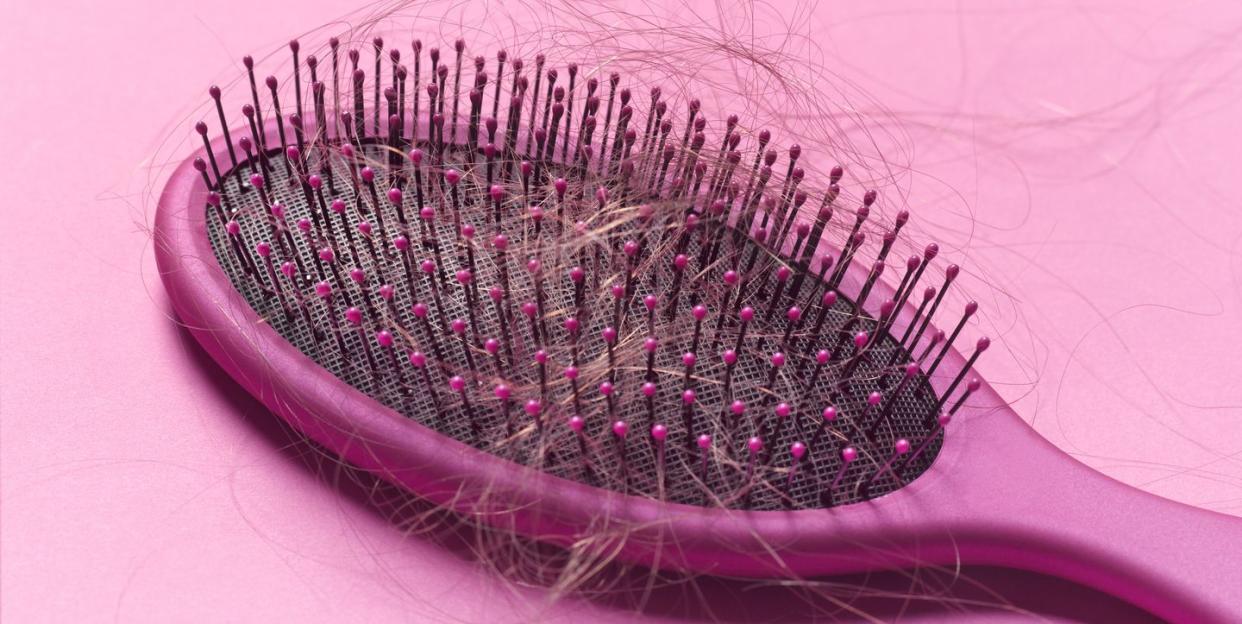Here’s how often you should clean your hairbrush — and how to do it correctly

We rely on our hairbrush to detangle our clean and dirty hair, day and night. But are you taking the time to care for your trusty tool as often as is needed? Probably not. So when you take a hard look at the surface of your brush, filled with lint and buildup, you may find yourself googling “how to clean hair brushes.”
Brushes need to be cleaned in order to remove the oil, dead skin cells, and styling products which cling to the brushes, says Mary Wendel, M.D., medical director at Medi Tresse. “Without frequent cleaning, the brush just makes clean hair oilier and potentially dirty again. Also, there can be a build up of bacteria and fungus on the brush, which can live on our scalps.” If your skin is sensitive, it is especially necessary to clean combs and brushes frequently, to avoid irritating the scalp and potentially clogging the hair follicles, she adds. If the irritation becomes severe enough, “it could interfere with healthy hair growth.”
But before you start hacking away at the layers of lint and hairballs covering your brush, there is a right way to go about cleaning it. Here, experts explain how to clean your hairbrush correctly, how often you really should be giving it a go-over, and when it may be time to say goodbye and start fresh.
How to clean your hairbrush effectively
It may be of little surprise, but the type of brush you use will dictate how to best clean it.
Step 1: Remove excess hair
Start by removing any hair that is tangled or trapped in the bristles, says Jennifer Korab, celebrity hairstylist and owner of Renaissance Salon and Revival Barber Shop. “Use your fingers or a comb to gently loosen and pull out the hair strands. You can also use scissors to cut through the hair and remove it in sections if it's tightly knotted.” Dr. Wendel adds that round brushes often require cutting the hair off.
Step 2: Soak (or dunk)
This is where the type of brush you use will affect how you clean it.
Plastic/synthetic: Plastic brushes or those made of synthetic materials are the easiest to clean, says Dr. Wendel. “Plastic brushes can be put into a dishpan or sink with warm water and around 2 tablespoons of shampoo.” Soak for about 10 minutes, followed by further cleansing with a toothbrush or cotton swab, Dr. Wendel suggests, and remove any visible remaining debris with the toothbrush.
While cleaning your brush with a clarifying shampoo is best, a good basic shampoo is good but make sure you are using one without added silicones & coatings because it will also coat the bristles of your brush, says Clyde Haygood, celebrity hairstylist and Pura D’or partner. “You can apply the shampoo straight to the brush or soak the brush in warm water with the shampoo in the sink or even a bowl deep enough for the water to cover/submerge the brush.”
If there is thicker buildup, it can help to use a toothbrush with baking soda to get between the bristles and then rinse with warm water, says Marisa Garshick, M.D., board-certified dermatologist at MDCS Dermatology.
Wooden/natural fibers: Wooden brushes and those with natural fibers should not soak, but rather be dunked into the warm soapy water after removing as much hair as possible, explains Dr. Wendel. “Further cleansing with a toothbrush will help remove remaining debris or buildup.”
Dr. Garshick agrees that it’s best to avoid exposing the wooden handle to water, so making sure that only the bristles are submerged is important. “Subsequently, you can then clean the bristles with a toothbrush.”
Step 3: Rinse and dry
All brushes should then be rinsed with clean cool water until all the soap is removed, says Dr. Wendel. “Paddle brushes need to be squeezed to remove any moisture underneath the plastic base,” she adds. The brushes should be allowed to air dry for at least 12 hours.
Some people like using a teaspoon of apple cider vinegar or baking soda in a bowl of warm water as a quick rinse before using soap, says Dr. Wendel. “This may be more aggressive in removing oils from the brush. If adding this step, use clean water when adding the shampoo after.”
After rinsing with water, all brushes should be laid on a towel with bristles facing down to dry, notes Blair Murphy-Rose, M.D., board-certified dermatologist at Laser & Skin Surgery Center of New York. But if you’re in a rush, Haygood says you can “dry the bristles with a hairdryer, if needed for immediate use.”
How often should you clean your hairbrush?
When your brush simply begins to appear not so fresh, specifically around the bristles, or if you find the brush isn’t performing quite the same as it used to, it may be time for a cleaning, says Harry Josh, celebrity hairstylist and creator of Harry Josh Pro Tools. “Typically, either product or build up from hair tends to collect around the bristles and can minimize the effectiveness of the brush, especially if you’re going for a smooth, sleeker look.”
How often you clean your hairbrush can depend on your hair, hair type, & product use, says Haygood. “If you have fine hair that uses a lot of products for volumizing, you may get product buildup quicker therefore you need to clean your brush more often. Those with oily hair will need to clean their brush more often so as to not redeposit oil into clean hair. People with coarse & curly hair may get more hair trapped in the brush quicker and therefore will need to clean their brush more often.” A general good rule of thumb is to clean your brush once a week, he says.
But going through this cleaning process once a week seems daunting to you, or maybe you’re thinking “but I don’t even use my brush everyday!”—don’t stress. There are small steps you can take so that each cleaning is less time-consuming and easier to keep in your routine.
First, always remove hair after you are done using your brush to keep bristles from bending, says Jessi Stramiello, hairstylist of Material Tampa Salon. Dr. Wendel adds that the hair should be removed from brushes 1-2 times a week (or as needed), and a thorough cleaning should be done every 2-4 weeks.
Why is it important to routinely clean your hairbrush?
Cleaning your hairbrushes is crucial for hair and scalp health, says Korab. “Bacteria and fungus can grow on your brushes, which then can transfer back onto your scalp.” It’s also important to keep them clean so you can optimize their use and keep your hair from getting oily/dirty, she adds.
More specifically, hair brushes accumulate oil (sebum), product residue, grime, bacteria, and yeast, explains Brendan Camp, M.D., double board-certified dermatologist at MDCS Dermatology in New York. “Using a dirty brush on the scalp can cause skin irritation, hair damage, and clogged pores.”
Finally, if you don’t maintain brush cleanliness, then the product and hair build up can actually lessen the effectiveness of the brushes performance and take away from your hair’s overall appearance, says Josh. Haygood agrees, saying “A clean hairbrush makes your hair look, feel & be its best.”
How often should you replace your hairbrush?
If the cleaning process alone feels like too much work, you may be wondering when you should just wish your trusty tool farewell and start fresh with a new brush. Like any good tool, hairbrushes need to be replaced periodically, says Dr. Wendel. “After cleaning a brush, examine it for broken or bent bristles or cracks in the base.”
Signs that indicate it may be time to replace your hairbrush include difficulty removing residue from the brush, visible grime or residue, and wilted bristles, says Dr. Camp. It’s best to replace your hairbrush when the bristles start getting bent and crooked, says Haygood. “It’s difficult to brush your hair smoothly when the bristles get like that and it can cause tension on your strands resulting in damage and breakage to the hair.”
A good rule of thumb is if even after cleansing the bristles properly and the appearance and or performance of the brush still doesn’t not get much better, then your brush may be on its last leg and due for a replacement, says Josh.
Some brushes can hold up well for many years, but others may need to be replaced every 6-12 months. Regularly check on how yours is holding up to ensure that you are treating your hair with a brush still in good working condition.
The bottom line
Clean looking hair requires a clean brush, says Dr. Wendel. “It makes no sense to wash your hair and then run a dirty brush through it, with a build up of dead cells, oils and styling products.”
As with everything we own, maintenance and proper care is important and will only further extend the life and performance of your brushes, says Josh. And always ask your stylist if you are using the right brush for your hair, says Stramiello. “Investing in a great brush will truly change the overall outcome of your style.”
- Hearst Magazines and Yahoo may earn revenue on some items through links in this article
You Might Also Like
